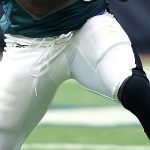In the early days of the NFL, neck rolls were a common sight on the gridiron, providing players with extra protection and support. These padded collars, often seen on linebackers and linemen, were designed to prevent whiplash and neck injuries.
However, as the game evolved and equipment technology advanced, neck rolls have largely disappeared from the field.
Today’s NFL players rely on modern gear that offers superior protection without the bulkiness of traditional neck rolls. Innovations in helmet design and shoulder pads have made older equipment seem outdated.
Additionally, the shift towards faster, more agile gameplay has influenced players to opt for lighter, more flexible gear. This change reflects the league’s ongoing commitment to player safety and performance optimization.
Moreover, the increasing emphasis on concussions and spinal injuries has led to advancements that provide better protection without restricting mobility. As a result, neck rolls have become a relic of the past.
The History of Neck Rolls in the NFL
Neck rolls, introduced in the NFL during the 1970s, were used to reduce neck injuries, gaining popularity especially among linebackers and linemen like Brian Bosworth and Howie Long.
Throughout the 1980s and 1990s, neck rolls became a symbol of the rugged NFL player, typically made from foam and vinyl fitting over shoulder pads. However, advancements in sports medicine and protective gear led to a decline in their use in the late 1990s.
By the early 2000s, NFL players moved away from neck rolls in favor of more advanced equipment that provided better overall protection while allowing greater agility, reflecting the evolution of the game and player safety improvements.
Evolution of Player Safety Equipment
NFL player safety gear has evolved significantly since the league’s inception, ensuring better protection and performance. This evolution has influenced various equipment, including the decline in neck roll usage.
Early Innovations
Early NFL safety equipment innovations included simple leather helmets and basic padding. Leather helmets debuted in the 1920s, providing minimal protection. Players started wearing shoulder pads in the 1930s.
By the 1950s, plastic helmets replaced leather ones, offering improved impact resistance. Equipment advancements in the 1960s and 1970s included better padding and the introduction of facemasks.
Modern Safety Gear
Modern NFL safety gear focuses on advanced materials and technology. Helmets now include multiple layers for impact absorption, along with advanced padding and a secure fit.
Shoulder pads are lighter yet provide better protection, using high-tech materials like EVA foam. Innovations in player safety gear prioritize both protection and performance.
For example, mouthguards and padded gloves contribute to reducing injury risk. Modern gear developments have minimized the need for older equipment like neck rolls, incorporating better neck protection into helmets and shoulder pads.
Common Reasons for Discontinuing Neck Rolls
NFL players no longer wear neck rolls for several reasons. These include advances in helmet design, the improvement of shoulder pads, and a focus on enhancing athletic performance.
Advances in Helmet Design
Modern helmets now provide better neck protection. Advanced materials and engineering have made helmets more effective at preventing neck injuries. Innovations help distribute the force of impacts, reducing the need for additional neck support like neck rolls.
Helmets now integrate padding and structural features to enhance safety comprehensively. Moreover, players prioritize mobility and flexibility, which can be restricted by neck rolls.
The evolution of training techniques also focuses on strengthening neck muscles, further minimizing the necessity for extra gear.
Improved Shoulder Pads
Shoulder pads have significantly improved, incorporating better neck and spinal protection while maintaining a player’s range of motion. Enhanced materials and ergonomic designs, coupled with advancements in medical research, reduce the need for neck rolls.
Consequently, NFL players now depend more on comprehensive equipment and training for safety on the field.
Moreover, these innovations have led to a decline in the use of neck rolls as players prioritize both protection and mobility. Modern gear allows for peak performance without compromising safety.
Enhanced Athletic Performance
Players prioritize speed and agility. Neck rolls, often bulky and restrictive, hinder performance. The trend towards lighter, more streamlined equipment assists players in maintaining high levels of athletic performance.
The reduced equipment mass also lessens fatigue, aiding in maintaining top performance levels throughout the game.
Additionally, advancements in helmet and padding technology have significantly improved protection, making neck rolls less necessary. Teams now focus on comprehensive strength and conditioning programs to prevent injuries.
Influence of Player Preferences
Modern NFL players prefer lightweight, streamlined gear to optimize performance, enhance agility, and speed. The reduction in bulk improves mobility and reaction times, while a sleek appearance aligns with current fashion trends.
Neck rolls are seen as outdated and uncomfortable, with modern helmets and shoulder pads providing similar protection. This preference for lightweight, stylish, and comfortable gear has led to the decline in neck roll use in the NFL.
Moreover, advancements in material technology have allowed for better protection without the need for bulky accessories. With the emphasis on player safety and performance, the traditional neck roll has become obsolete.
Impact on Game Dynamics
The decline in neck roll usage has significantly influenced game dynamics.
Speed and Agility
Speed and agility are essential in modern football, prompting players to choose lightweight gear over bulky neck rolls. Improved helmet and shoulder pad designs provide better protection, reducing the necessity for neck rolls and enhancing performance.
Training programs now focus on neck strength, further minimizing the need for extra padding. This combination of advanced equipment and specialized conditioning keeps athletes safe while preserving their mobility.
Playing Style
Playing style in the NFL has evolved to favor more dynamic and flexible techniques. Defensive and offensive schemes now demand higher agility from all players. Neck rolls can limit this flexibility, making them less favorable.
Additionally, the shift from power-based to speed-centric gameplay places a premium on equipment that offers protection without hindering mobility.
Another factor is advancements in sports medicine and protective gear, which provide better alternatives to neck rolls. Helmets and shoulder pads have improved significantly, offering enhanced safety features.
Frequently Asked Questions
Why have neck rolls declined in the NFL?
Neck rolls have declined in use due to advancements in sports medicine and improved neck protection integrated into helmets and shoulder pads, making them less necessary.
How has modern equipment impacted player performance in the NFL?
Modern equipment is lighter and more streamlined, helping players enhance their speed and agility, which is essential for the dynamic and flexible playing styles favored in the NFL today.
What role does sports medicine play in the evolution of NFL safety equipment?
Sports medicine has played a significant role by developing improved gear that offers better protection, contributing to a decline in traditional equipment like neck rolls.
Why do players prioritize lightweight gear in the NFL?
Players prioritize lightweight gear to improve their speed and agility, crucial for the high-paced and dynamic nature of contemporary football.
Is neck protection still a concern for NFL players?
Yes, neck protection is still crucial, but modern helmets and shoulder pads provide integrated solutions that offer better protection without compromising flexibility.
Conclusion
The evolution of NFL equipment underscores the league’s commitment to player safety and performance. Neck rolls, once essential, have faded due to advancements in protective gear and the growing emphasis on speed and agility.
Modern helmets and shoulder pads now offer superior neck protection without compromising flexibility. This shift reflects the NFL’s dynamic nature, where innovation continually shapes the game.
As the league evolves, equipment will likely keep pace, ensuring players remain protected while optimizing their performance on the field.
Moreover, the increased focus on medical research and injury prevention has driven teams to favor more versatile and less cumbersome alternatives.
As training methodologies advance, the need for highly specialized gear diminishes, allowing for a more streamlined approach to player safety.
Additionally, the integration of improved safety protocols and educational initiatives regarding tackling techniques have reduced the necessity for such bulky equipment. Consequently, neck rolls have become largely obsolete.








Ashley Hopkinson